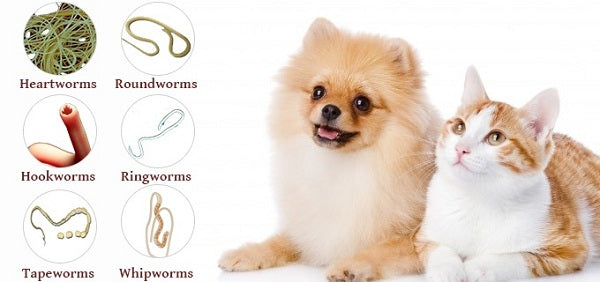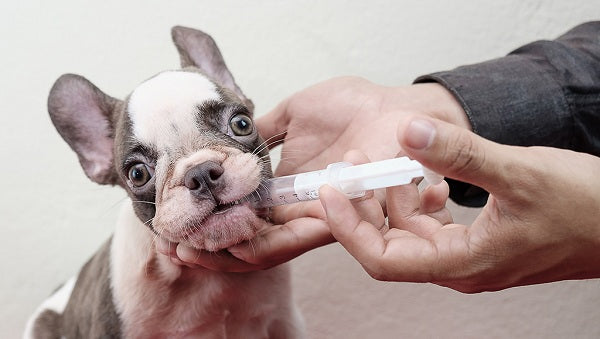Worms or parasites are common problems encountered in canine veterinary practice. Several different types of worms may be seen in dogs such as roundworm and hookworm. In this article, Happy & Polly will tell you how to recognize signs of worms and the ways to deworm your dog.

It is best to be confirmed by a vet examining a stool sample. Your vet can recommend suitable repellents for dogs based on the type of worm in your pet. Before giving your dog a dewormer, even over-the-counter medications, be sure to consult a vet.
Signs of worms
Not all infected dogs show obvious signs. So it is important to give them regular treatment whether they have worm symptoms or not.

Common signs:
- Weakness and loose motion
- Grow slowly
- Diarrhea
- Vomiting
- Eat a lot but still losing weight
- Abnormal swelling of the belly button
- The stool contains spaghetti worms, mucus or blood
Remember that in addition to worms in the stool, these symptoms may also indicate other health issues-so be sure to check with your vet.
Types of worms
Intestinal worms such as hookworms can make your dog unable to effectively absorb nutrients and vitamins, which can also cause blood loss and anemia. It can also threaten your puppy's life.
Humans can also be infected with these parasites, which can cause intestinal pain, diarrhea and more serious health issues, such as blindness and respiratory diseases. Here are some common types of worms may be seen in dogs.

Roundworms
Many dogs are born with roundworms. These larvae are introduced into the developing dog through breast milk or the mother's uterus before birth. Roundworms are most common in dogs and can cause varying degrees of diarrhea, vomiting and weight loss, but appetite usually increases. Some dogs develop roundworms or other types of worms on their abdomens.
Hookworms
Hookworms are thin worms that attach to the wall of the small intestine and absorb blood. Severe infections may even kill dogs because severely anemic caused by Hookworms. In older dogs, chronic hookworm infection can cause low physical strength, decreased appetite, and weight loss. Other symptoms of hookworm in dogs include bloody diarrhea, anemia, and weakness.
Tapeworms
Tapeworms are another worm commonly found in dogs. Dogs can be effected by swallowing fleas that carry tapeworms. Tapeworms will absorb nutrients from the intestines they attach to. Tapeworms are made up of small rice-sized segments. These are passed through the feces and can sometimes be seen around the dog's anus.
Humans can also be infected with tape worms, but people cannot get worms from infected pets. In many cases, tapeworm does not cause serious clinical symptoms, but it can usually be diagnosed by finding tapeworm segments in the feces or near the rectum of an affected dog.
Whipworms
Whipworms are thread-like worms. Whipworms live in the area where the large and small intestines meet. It may cause symptoms such as mucousy or bloody stool, low appetite, and weight loss. These worms also suck blood and cause anemia.
Whipworms are difficult to diagnose, as a microscopic exam of several fecal samples may be necessary to detect them. Whipworms can also be one of the most difficult worms to eliminate but they are both treatable and preventable.
Heartworms
Mosquito bites can cause dogs to get heartworms. Heartworms up to 14 inches long live in the heart and the arteries that carry blood from the heart to the lungs. Heartworms can affect the function of the heart and blood clots, and if left untreated, it may cause death. Preventing heartworms every month is effective. If infected, your dog may cough, have difficulty breathing, and develop other symptoms.
Ringworm
Although it is called a worm, it is not a worm at all. It is a skin infection caused by f a fungus. Ringworms in dogs usually appear as dry, gray, scaly patches. A dog's skin can get ringworm when it comes in contact with the spores of the fungus. Spores are usually found in soil or cats. Treatment of canine ringworm may include medicated dips, shampoos or ointments.
You should first collect a fresh stool sample of your dog and take it to the vet. Then according to the diagnosis of the vet, you can know which type of worm your dog gets. Different worms require different medication.
How To Deworm Your Dog
- Choose a proper dewormer for your dog’s worm
Though worms are a nuisance, they are fairly easy to take care. First, you should ask your vet or do some research for the medication your dog needs according to the above said diagnose. If you give your dog the wrong kind, you may not be able to effectively infect the parasites infected by your dog.
- Weigh your dog to ensure the right dosage
It is best to give your dog the medicine immediately. After you get the accurate weight, please refer to the drug dosage table. It is very important for dogs to receive enough medication to kill or repel worms. Too much medicine is not good.
- Fill a syringe.
If you have to fill your own syringe, immerse the top of it in the liquid medication, and then pull the plunger back to fill the vial with liquid. Fill in the amount recommended on the package. If you are going to give your puppy medicine, or if the syringe is pre-filled with packaging, you can skip.

Check whether the medication should be taken when you are full or fast. In order for the medicine to be effective, you need to follow the guidelines.
- Distract your dog
Flick your fingers, wave a toy, or hold a snack in front of the puppy's nose, so that the puppy can focus on your hand. Dogs are easily distracted, so once you get their attention, please act quickly and provide them with deworming medicine.
- Open your dog’s mouth with another hand.
Gently open the dog's mouth, and slide your fingers between the lips and apply steady pressure to open the jaws. After the dog opens its mouth, you can put medicine in it.
If you are administering medicine through a syringe, place the tip of the syringe at least 2 inches (5.1 cm) inside the dog's mouth, and then dispense the liquid. The dog should swallow it quickly.
If you are going to give a pill to a dog, place it back about 3 inches (7.6 cm) in the dog's mouth so that it will swallow the pill without vomiting back.
Give your dog medicine on the schedule recommended, which is the most effective way.
- Take Dog’s final stool sample to your vet
After the deworming treatment is over, collect another stool sample from your dog. Take this sample to the vet to check for worms and confirm that your dog is free of worms.
Worming schedule
Many dogs are born with worms and get more from breast milk. So it is so important to stick to a treatment schedule.
Treat your dog to prevent worms in the following time:
- 2 weeks old
- 1 month old
- 6 weeks old
- 2 months old
- 10 weeks old
- 3 months old
- 4 months old
- 5 months old
- 6 months old
After your dog is six months old, they should do it at least every three months. In addition, you can apply for Advocate every month starting from 7 weeks of age to protect against most gastrointestinal worms.
We hope this can help you take care of your pet. If you enjoyed it and would like to see more news, do not hesitate to visit Happy & Polly website on https://happyandpolly.com.

